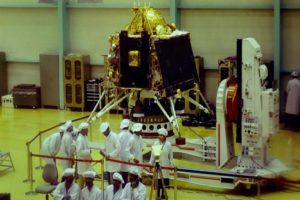 Chandrayaan 2 is India’s second mission to the Moon and the historic lunar landing of a rover is all set to be made with a tricolour and ISRO logo embodied in the wee hours of September 7, 2019. The Vikram lander, after landing on the moon, tonight, will have Pragyan Rover exposed to the sun which is attached to the doors. The mission has three modules namely Vikram lander, Pragyan rover and an orbiter.
Chandrayaan 2 is India’s second mission to the Moon and the historic lunar landing of a rover is all set to be made with a tricolour and ISRO logo embodied in the wee hours of September 7, 2019. The Vikram lander, after landing on the moon, tonight, will have Pragyan Rover exposed to the sun which is attached to the doors. The mission has three modules namely Vikram lander, Pragyan rover and an orbiter.
The Pragyan rover is a six-wheeled robotic vehicle that weighs 27kg and can generate 50 Watts of power. It can travel up to 500 meters and can communicate only with the lander. It detects all major elements required for rock-forming like Magnesium, Aluminium, Silica, Calcium, Sodium, Titanium, Iron, and some other trace elements like Yttrium, Strontium, and Zirconium.
Pragya rover will travel at a speed of one centimetre per second and a total distance of half a kilometre. When the lander makes a soft landing on the Moon, the rover will roll out and start its exploration. There are two instruments onboard that will test the mineral and chemical compositions of the surface of the Moon along with the soil and rocks.
While Chandrayaan-1 found water on the Moon’s surface, this rover today will try to find if the water is present on the permanently shadowed parts of the Moon. The south pole of the Moon also contains ancient rocks and craters that could help in learning more about the history of the Moon.
One of the instruments on Pragyan is a Laser-Induced Breakdown Spectroscope (LIBS). Its main objective is to identify the elements that are present near the landing site. To do this, laser pulses are fired at various locations and the radiation from the decayed plasma is analysed. The rover wiill spend a total of 14 Earth days and India is about to create history with the closest cosmic body.

























